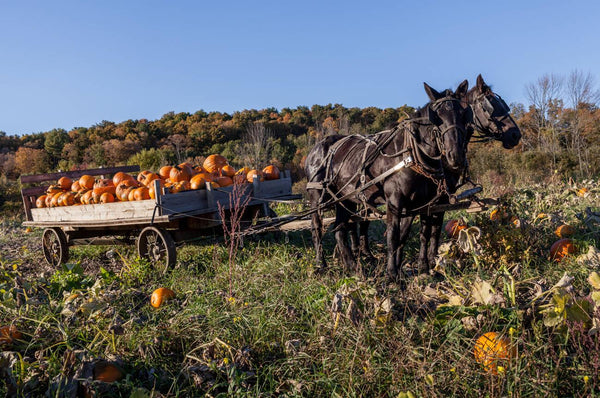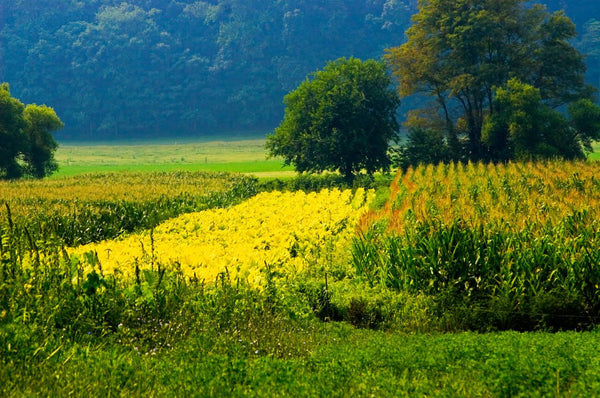Have you ever thought about how the Amish farm their land without using modern tools? Well, get ready to be amazed! Farming forms a great part of the Amish economy, and they’ve even formed an Amish bank.
The Amish are masters of traditional farming methods passed down for generations. They rely on horse-drawn plows, hand-held scythes, and good old-fashioned hard work to cultivate their fields and bring in the harvest. But there’s more to Amish farming than just the tools they use.
Amish farming methods are rooted in a deep respect for the land and a commitment to sustainability. So let’s take a closer look at the fascinating world of Amish farming methods and discover what makes them unique.
Traditional Amish Farming Methods
You might think of tractors, combines, and other high-tech tools when you think of farming. But the Amish do things a little differently.
We’ll look more closely at some of the traditional ways the Amish work their land and gather their crops. Get ready to learn about some seriously cool old-school farming techniques!
Organic Farming
The Amish are fully committed to organic farming. They’re all about using natural and sustainable practices to grow crops and raise animals. They make their compost out of food scraps and animal manure. It’s a great way to make the soil richer and help the crops grow nicely.

The Amish also prefer to get rid of pests naturally. They may plant certain plants that bugs don’t like or use row covers to keep them out. That way, the food they produce is super healthy and free from chemicals. They also refuse to feed their farm animals hormones and antibiotics.
They also plant “cover crops” like clover and rye. These crops help keep the earth healthy by stopping it from washing away and holding its shape. Plus, it feeds the animals too!
Crop Rotation
The Amish make use of a technique called crop rotation. It’s where they plant different crops in the same field over several years. This method helps to keep the soil healthy and nutrient-rich. They grow crops like corn, wheat, soybeans, and even cover crops like clover and rye.
Crop rotation prevents the soil from becoming depleted of certain nutrients. The best part is that pests and diseases don’t have a chance to build up in the ground when crops are rotated. Crop rotation makes their crops less likely to be attacked and damaged.
This farming method helps the Amish reduce the amount of fertilizer and other chemicals they use on their crops. That’s because rotating crops naturally replenishes the soil with the nutrients plants need to grow healthy and strong.

Horse-Drawn Farming Methods
The Amish are known for choosing horse-drawn farming methods over more modern tractors or other fancy machines. The horses do most of the hard work, like pulling plows and other equipment through the fields. It lets farmers work in the field without relying on fossil fuels.
Using horses is also part of their religious beliefs. They want to avoid using technology that might separate them from their community or make them too proud. By using horses, they stay connected to their roots and the land.
A horse-drawn farming method is a slower process than modern industrial farming. This slower time lets farmers take their time and work in harmony with the land.
Traditional Tools
The Amish’s love for all things traditional can be seen in their farming tools. Besides the horse-drawn tools, they use tools to connect them to their past and to keep their methods sustainable and environmentally friendly.
Some of their tools include hand-cranked seeders and hand-held scythes. They use hand-cranked seeders for all sorts of crops, and the hand-held scythes make cutting hay and other crops a little less challenging. Many tools are handmade, just like their picnic baskets, Easter baskets and bread baskets.
Even though these tools aren’t very high-tech, they get the job done. With some elbow grease, the Amish are experts at reducing their carbon footprint and working harmoniously with the land.
Community Help
The Amish are all about community, and it’s no different when it comes to their farming methods. Everyone pitches in to get the job done, and they use traditional tools and techniques, like Amish woodworking techniques, to keep it authentic.
It’s not uncommon for them to share resources. In fact, during the times of slavery, the Amish helped slaves and provided resources to aid them in their escape. They’ll help fellow Amish by lending each other equipment, or they’ll help out with big tasks like planting or harvesting. This helps foster a sense of community and togetherness.
Barnraising is quite a big deal. This event is when the Amish work together to help build or repair a barn for someone in the community. A barn raising is a fantastic showcase of the hardworking and organized nature of the Amish people.
The barn raising not only provides practical help but also allows the community to bond and come together for a common goal.
Conclusion
The Amish have some remarkable farming methods. They keep it old school with their tools and techniques, and their respect for the land and sustainability is impressive.
Even more impressive is how well they work as a group. They share resources and have a strong work ethic that benefits everyone involved. Their sense of community can’t help but inspire you.
If you’re wondering “How do the Amish cut grass?”, or you’re curious about the Amish money system, or the average Amish net worth, take a look at our website for more information!
Did You Find Our Blog Helpful? Then Consider Checking:
- Amish Farm and House vs Amish Village
- How Do the Amish Buy Land?
- Are Amish People Jewish?
- Are Pennsylvania Dutch People Amish?
- Amish Communities in the United States
- Where Do Amish People Live?
- Amish Lifestyle
- Do Amish People Listen to Music
- What Do Amish Do for Fun
- Do Amish Hunt
- Amish Technology
- Do Amish Use Electricity
- Do Amish Use Cell Phones
- Do the Amish Use Guns
- Do Amish Watch TV


